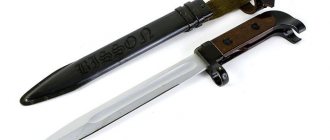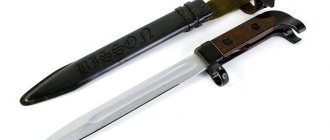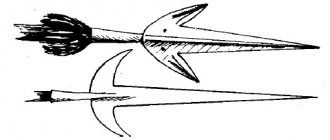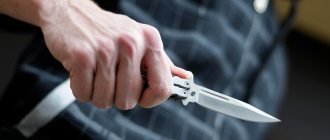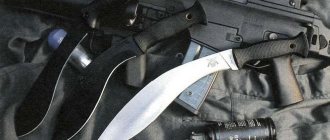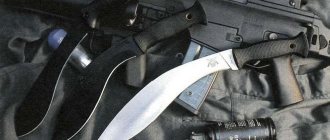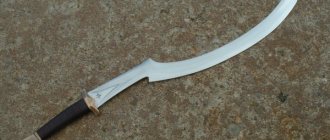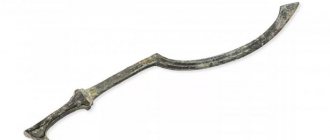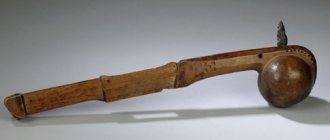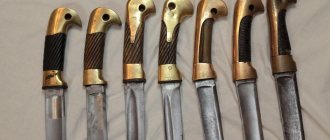The weapon that will be discussed has a rather interesting history of its appearance, and, unfortunately, its decline in use. There were times when a bayonet and knife was a mandatory attribute of a firearm. Any musket or rifle was necessarily equipped with it. But as time passed, the tactics and strategy of combat changed. And the use of a bayonet-knife in its original form has become irrelevant. But not everything is so sad, in fact, it still serves “faithfully” to many world armies.
General information about bayonets
A rifle bayonet is a bladed weapon, the main purpose of which is to defeat the enemy with a powerful piercing blow in hand-to-hand combat. The weapon is attached to the muzzle of a rifle, shotgun, carbine or machine gun. Depending on the type, all bayonets can be divided into the following groups:
- Faceted or needle bayonets. Unlike bladed models, these weapons were small in size and easily hit enemy bodies. While bayonet attacks played a huge role on the battlefield, this bayonet was out of competition, but with the advent of machine guns, it lost its position;
- Bladed bayonets. A typical example of such a weapon would be a bayonet from a Kalashnikov assault rifle. It allowed not only to chop, but also to stab. In addition, with the help of a bayonet knife you can perform a lot of different chores.
All weapons of this type are divided into categories depending on the method of attachment:
- To the tip of the fore-end and to the stock ring at the same time;
- To the trunk;
- Be removable or non-removable;
- Folding.
Currently, folding bayonets are considered the most advanced modification, but they should soon disappear completely.
Bayonet cold weapon in Russia or not
The question is not as difficult as the answer. Having studied many specialized Internet resources, and even visited forensic experts at the Ministry of Internal Affairs forum. It was not possible to find specifics; everything is veiled: norms, GOSTs and other bureaucratic documents.
Often they themselves cannot answer the question whether a bayonet is a cold weapon or not. But in general terms, a picture emerges like this:
- An important point is in the form of fastening the bayonet-knife. Fixed products will technically be considered entirely with a carabiner. He is easily recognized as a cold person. It's crazy, but this happens. Depends on the specific forensic police officer. With removable bayonets it is a little easier, if there is no full-fledged handle or changes in design - store it separately from the firearm and there will be no problems.
- Original bayonets for carbines based on AK, SVD and the like should not be installed. They were put into service as separate combat units and have the GRAU index. According to the law on weapons, it will certainly be a combat weapon. They are prohibited for circulation by civilians.
- With replicas or emasculated bayonets, everything is much happier. They are easy to purchase in a store with a household certificate. To recreate a full-fledged carbine, the safest way. Cooling is carried out in two ways: by cutting or tempering the steel. The second option has no differences from the original, but the hardness of the blade becomes below 42 HRC.
- Foreign-made bayonets will not be considered military equipment. It is necessary to have a certificate equating it to household items.
Finnish bayonet on a Mosin rifle.
If you have any doubts about your specific bayonet, have it examined. A bayonet is recognized as a bladed weapon - register it according to the law, otherwise problems cannot be avoided.
Rifle bayonet: history of development
The bayonet weapon is a direct descendant of the combat pike, which in turn is the last round of the evolution of the spear. Before the advent of the first firearms, edged weapons were the main weapon of infantry. When entire detachments armed with muskets appeared, edged weapons gradually began to lose their position. But since the musket needed a long reload, detachments of pikemen were given to help the musketeers. The life of a soldier with a pike was short, since he could only fight in close combat, so these units gradually disappeared.
Since after the shot the shooter found himself practically unarmed, he needed a specific weapon that would not interfere with his ability to wield a firearm. This is how the first samples of baguinettes appeared - long blades that were inserted directly into the barrel of a musket. This weapon interfered with reloading, but in the conditions of a fleeting battle it coped well with its duties.
In 1699, the first bayonets appeared, which did not interfere with the reloading process at all. Soon these weapons almost completely replaced pikes from the battlefield.
Application tricks
The best gunsmiths worked on the design of bayonet knives for AKs, equipping the blades and handles with many additional parts. These convenient additions turn bayonet knives into a versatile tool that can help solve a variety of tasks. Many application features were invented by the users themselves, who have owned bayonets for a long time and tested their capabilities in field conditions.
Fire source
There is a small area at the bottom of the sheath that is rough to the touch. This area is intended for making fire. You can strike a match, or use a stone and rags and light a fire, striking a spark.
Smokers use the hole under the strap on the scabbard as a cigarette holder; if there are no cigarettes, only cigarette butts remain. By securing the small remainder of the smoke in the groove, you can finish smoking it to the end.
General purpose tool
In everyday life, blades and sheaths are used in a variety of ways. A sharp blade is used to open canned food - an indispensable product on camping trips. The knife is inserted into the sheath with the cross ring and a hammer is obtained, which is used to hammer in tent pegs. The notches can be used to cut branches. When the blade and sheath are connected, scissors or wire cutters are obtained, and the blade easily functions as a screwdriver.
A spear
If necessary, the bayonet-knife can turn into an ancient throwing weapon - a spear. For this purpose, special devices are included in the kit (trainer, carabiner). The owner needs to find a straight stick that will act as a shaft and secure the blade to the end. You can go hunting or fishing, and also use it in close combat.
Torch
In the dark, you can illuminate yourself using the scabbard, like the handle of a torch. There is a spring hidden inside the case that is easy to remove. It is attached to the bottom of the sheath in a special groove.
You need a small piece of oiled cloth, which is attached to a spring and set on fire. The torch is held by the sheath, the design is reliable, it does not fall apart, the burning fabric will not break off and will not burn your hands.
Engineering tool
In field conditions, a knife is used to perform engineering and sapper work. For this purpose, there are special notches and teeth on the butt, with the help of which you can bite through a wire or wire, or saw through a rod. Even live wires will not stand, since the handle is made of dielectric material.
Types of bayonets
The first bayonets were faceted and had a tubular mount. The classic Russian bayonet, which was glorified by the great commander Suvorov, belongs to precisely this variety. In addition, these edged weapons come in the following varieties:
- Bayonets with a tube with and without slots;
- Tube bayonets with lock;
- Tubular without clamps;
- Bayonets that are fastened with clamps;
- Bayonets with clamps of a screw design;
- Bayonets with latches.
In addition to faceted bayonets, a completely different group developed - cleaver bayonets. This weapon was more functional, although in battle the same Russian bayonet was significantly superior to them in speed and maneuverability.
In Dahl's dictionary
m. German triangular butt, a spear mounted on a soldier's rifle. A bayonet tube with a lock that screws onto the front sight, a muzzle sight; from the tube there is an elbow, which turns into a triangular spear inclined to the axis of the gun. The bullet is stupid, the bayonet is great, Suvorov. Go with hostility, with bayonets, in hand-to-hand combat. On hand! with hostility. He dodged the bullet, but did not fall off the bayonet. Where the bullet doesn't reach, the bayonet will pick it out. Some with a bayonet, some with a butt. The bayonet has a sharp nose. Don't get caught under his bayonet. The bullet will deceive, but the bayonet will not give up (will not give up). Climb on the bayonet and point at yours! If you don't have enough bayonets, we'll give you a butt (soldier's). The bayonet is not dexterous, so forward the butt, 1812 | An ingot, a bar of gold, silver, copper, sometimes lead (pig). | For excavators: layer, layer, how deep a shovel can go at once. They count three bayonets per arshin depth. | Morsk. knot of a known sample, of which esp. thick ropes, perlina, cables are tied, the rope is tied to the anchor eye. Knit with a bayonet and grab the ends with a heel. | Bayonet, Donsk. teak, mottled, shabby, striped, bayonet thief. Bayonet scabbard, bayonet. Bayonet copper, which is in bayonets. *Bayonet work, clumsy, rough, simple. Bayonet a digger to dig up the ground with shovels (Naumov). Bayonet edges. Bayonet (-boot) m. morsk. a rope with which the edge (luff) of the sail is attached to the tip (end) of the yard when taking reefs. The bayonet sailor is the most dashing of the mars. Shtykyunker old. artillery rank, between sergeant and lieutenant.
German bayonets of two world wars of the 20th century
Before the outbreak of World War I, Germany was the leader in the production of rifle bayonets. German weapons of this type were distinguished by a huge variety of models, which can be seen in the rare surviving photographs of those years. The most popular bayonet was the 98-05 model, which was represented by bayonet knives. This weapon was significantly different from the same Russian bayonets of the Tsarist and even the Soviet army.
This weapon proved to be so successful that German soldiers used them not only in the First World War, but also in the Second World War. Due to the fact that these bayonets were forged from high-quality metal, many models of those years have survived to this day.
From baguette to knife
In 1795, being the commander-in-chief of the army in the south of the empire, Count (he would become a prince a little later) Alexander Suvorov-Rymniksky wrote the well-known “Science of Victory” - a collection of instructions on combat and tactical training of troops. The book consisted of two parts: “Divorce training, or before divorce” and “Verbal teaching to soldiers about the knowledge necessary for them.”
Actually, the first part was addressed mainly to commanders and was a guide to training battalions and regiments. The second is a kind of training manual for soldiers, which described both various features of battle tactics and, in general, the basic rules of soldier behavior - the code of the Russian warrior. A Russian warrior should not “think about any retreats in the infantry and cavalry”; must save “a bullet for three days, and sometimes for an entire campaign”; must “shoot rarely, but accurately,” that is, “completely” (accurately), and most importantly, must “stab firmly” with a bayonet. How did it happen that before Suvorov (in the 17th century), during (in the 18th century) and even long after (in the 20th century) the bayonet was and remained “well done,” the author of diletant.media, Yuri Kukin, looked into it.
Since the 15th century, firearms have been gaining increasing popularity in Europe, and even in closed Japan, at the end of the 16th century, troops armed with guns appeared. However, for example, a gun in the 18th century was not much different from a gun in the 17th century. For example, they were also difficult to reload, since the flintlock, even being the most common for more than two centuries (it was in use until the first quarter of the 19th century), had flaws such as frequent misfires coupled with a powder cloud when fired, which closed overview of the shooter, etc. All this affected the accuracy and speed of fire.
At the same time, the use of firearms inevitably entailed a gradual abandonment of heavy types of weapons and armor (not counting cuirasses, which heavy cavalry continued to use in the 19th century) in favor of lighter ones that allowed them to maneuver freely and remain effective in battle. Therefore, the bayonet in some way became this new universal weapon, which, in essence, turned the gun into a spear.
Spanish baguinet from the 18th century
True, as a bladed weapon that was attached to a firearm, the bayonet first appeared in the second half of the 16th century in Northern Spain. It was a blade with a wooden round handle, which was inserted into the barrel of a musket, initially used not in battle, but in hunting when finishing off an animal, since it was often difficult to kill an animal (especially a large one) with one or even several shots. Such a blade is called a baguinet or bayonet, although there is a common belief that the bayonet received this name almost a century later in the 40s of the 17th century, after the name of the French city of Bayonne, where it was already used in battle, and not in hunting. And indeed, already in the second half of the same century, baguettes, along with guns, were in the arsenal of many armies of Western Europe.
The name baguinet bayonet appeared in the 1640s
Grenadier of the French Guard regiment, late 17th century.
At the same time, such a “gun-baguette” combination had a serious drawback: since the blade was attached directly to the barrel of a firearm, it was impossible to fire a shot and at the same time be ready to attack with a bayonet. However, this problem was solved at the end of the same 17th century with the advent of a bayonet with a tube (bushing), which was fitted onto the barrel of a gun. The bayonet was usually located on the right along the axis of the muzzle, since in hand-to-hand combat the blow was directed with the right hand on the butt. But from the end of the 19th century, bayonet knives were more often attached to the bottom of the muzzle.
Russian bayonet
Since the 18th century, bayonets have been an integral part of any battle, and the armies of different countries, which had a sufficiently developed industry to equip soldiers, had their own peculiarities in the production of both guns and bayonets. For example, unlike European ones, in the Russian army various cleaver bayonets (with scimitar-type blades or with a saw on the butt) were not very popular. The greatest preference was given to a bayonet with a needle blade in both the Russian and Soviet armies (until the end of the 40s of the XX century).
From left to right: cleaver bayonet, scimitar-type bayonet, French bayonet for the Lebel rifle
In Russia, the bayonet replaced the baguinet in 1709, although the earliest surviving examples date back to 1731. In general, these were still different types of options, but subsequently, with the advent of standard models of handguns, bayonets were also brought to a certain unified standard. As a rule, it was a large triangular blade - a truly deadly weapon: the length of the blade varied from 350 to 380 mm with a width of 28 mm.
The triangular needle bayonet was called Russian
Triangular bayonet
A blow with a triangular bayonet left a lacerated wound, which was much more difficult to treat than a simple injection or cut, and given the length of the blade, it can be assumed that it also caused serious damage to internal organs. It is not surprising that the soldiers were afraid of hand-to-hand combat, preferring to exchange volleys of shots. Suvorov, on the contrary, insisted on three important tactical components of the infantry soldier - “eye, speed and onslaught,” where the latter was characterized precisely by bayonet fighting: “The enemy has the same hands, but he doesn’t know the Russian bayonet. Draw a line, attack immediately with a cold gun.”
Mosin rifle 1891 with a tetrahedral bayonet
The “Russian” triangular bayonet was replaced by a more sophisticated tetrahedral one: with a longer (on average 500 mm) but narrow (20 mm) blade, which existed almost until the end of the Second World War. It was first adopted for the Berdan rifle of the 1870 model, but the most famous rifle with which the tetrahedral bayonet was used is the Mosin rifle of 1891. The famous “three-line” was already sighted together with the bayonet, so in most cases it was used without detaching the bayonet. After the war, during rearmament, the tetrahedral bayonet was gradually replaced by a more modern knife bayonet.
The “three-ruler” was sighted together with a tetrahedral bayonet
Bayonet for AK74 with saw
During World War I, it became clear that cleaver bayonets (which were popular in Europe) with their long blades needed to be shortened. This is how the bayonet-knife appeared. It is essentially a knife that can be attached to a firearm, although in English the terms "bayonet" and simply "bayonet" are referred to by the same word - bayonet. At the same time, unlike the bayonet, which performed only a specific function, the bayonet-knife also serves as a household tool for the soldier (can be used as wire cutters, a file, etc.).
And even despite the fact that bayonet fighting and hand-to-hand combat in general in the modern world seem to be giving way to ever new types of combat operations, the tradition of training in the use of weapons with a bayonet is still developed in many countries, and most modern military firearms are equipped with a bayonet mount weapons.
Sources:
Kulinsky A. N. Russian edged weapons of the 18th—20th centuries.
T. II. Saint Petersburg. 2001. Suvorov A.V. Science of winning. M. 1980. Yugrinov P. Small encyclopedia of edged weapons. M. 2010.
The famous bayonet for the Mosin rifle
The first bayonets for the Mosin rifle appeared before the start of the First World War. If you look up the archival documents of those years, you can see that initially it was proposed to make the Mosin bayonet a knife type. However, supporters of classic needle weapons managed to insist on the old design. Mosin rifles continued to be produced in the USSR after the Civil War, with several bayonet upgrades.
It should be noted that in the USSR they mainly modernized the bayonet mount, leaving its shape unchanged. During the Great Patriotic War, bayonets with knife or even dagger blades appeared, but these were homemade.
SVT bayonet: a weapon of the Soviet period
By the mid-1930s, the Soviet command decided that the future belonged to blade-type bayonets, and the new SVT-38 rifle received a knife bayonet, which was clearly made based on the German model 98-05. Looking at the German army, the government decided that the bayonet for the new rifle should be worn on the belt, put on the weapon only when necessary.
Indeed, weapons with automatic reloading did not need a blade constantly attached to it. Nevertheless, the bayonet turned out to be quite formidable and long. Tests have shown that such a length is not needed, so the modernized SVT-40 rifle received a shorter detachable bayonet. The Second World War also showed that it was too early to write off bayonets - sometimes soldiers still had to make a bayonet attack.
In Vasmer Max's dictionary
I I, b. p. -a, starting with Peter I; see Smirnov 338. Through Polish. sztych “sharp, piercing weapon” (Sɫown. Warsz. 6, 678) from the Middle Ages. stich "spear thrust"; see Groth, Phil. Once. 2, 518; Mi. EW 344; Brückner 556; Karlovich, AfslPh 3, 664; Trans., Proceedings I, 109. Not directly related to the Swiss. stick “sliver, splinter”, contrary to Matzenauer (338). II II “knot, securing the end of a rope with a sea knot.” From the Netherlands steek, N.-German stek – the same; see Meulen 199 et seq. Hence bayonet “to sew two pieces of something together over the edge,” Kashinsk. (Cm.). The vowel -ы-, possibly from poke.
SKS bayonet and its features
After the end of the Second World War, the Simonov self-loading carbine was adopted by the USSR army. The results of the Second World War showed that the removable bayonet-knife has some disadvantages, so they decided to equip the new weapon with a folding, permanent bayonet that does not interfere with transportation. SKS bayonets were produced in two types: needle and knife. This mounting design has not yet been used in the history of Russian weapons, so there were many opponents of folding models.
However, it was impossible not to agree with the statements of the designers, who argued that detachable bayonets were practically useless in a sudden hand-to-hand attack. Also, the folding design was safe both for the shooter and for the people around him.
Requirements for new types of bayonet knives
The requirements for military knives today are quite modern and there is nothing unusual about them. Taking into account the development of various technologies, designers need to use a little imagination and the blade will certainly delight any fighter:
- In the first place, of course, remains the size and shape of the knife.
- When striking them, the wounds must be as damaging as possible, and it is also necessary to be able to quickly remove the blade for a second attack.
- Working with one hand with a bayonet, it should be possible to use the fighter’s second hand, for example, arming it with a second combat blade.
- When moving using the Plastun method, the product should not interfere or get lost during movement.
Modern small bayonet.
From these simple requirements we can conclude: the blade is small, there are fewer clinging elements, it is easy to use and the sheath is reliable. This is what the modern soldier wants.
AKM bayonet and its modifications
The first Kalashnikov assault rifle, which entered service in 1949, was completely devoid of a bayonet. Only after modernization in 1953 did he finally acquire these archaic edged weapons. The bayonet was called 6X2 and almost completely copied the SVT-40 bayonet. The only difference was the locking mechanism.
The bayonet for the AKM was made on the basis of the Navy reconnaissance knife, which was designed by Lieutenant Colonel Todorov in 1956. For the AK-74, its own version of the bayonet, model 1978, was developed.
In 1989, another modernization of the AK bayonet took place, but the terrible quality of these bayonets made all the engineers’ efforts useless.
Currently, bayonets are living out their last days. According to military experts, they will soon disappear completely.
In the dictionary Dictionary of foreign words
I
a, m.
A piercing weapon attached to the end of a rifle or carbine barrel. Bayonet - relating to a bayonet, bayonets. With hostility (to meet, accept someone or something) - extremely hostile. To hold on to bayonets, to rely on bayonets - to hold on by the strength of troops, to rely on the strength of weapons. Like a bayonet (colloquial) - absolutely, absolutely. II
a, m.
A layer of earth to a depth that can be captured by a shovel. Dig the ground to a depth of one and a half bayonets.
Bayonet - relating to a bayonet, bayonets. Bayonet (special) - dig to a depth that can be captured by a shovel.
Share the meaning of the word:

